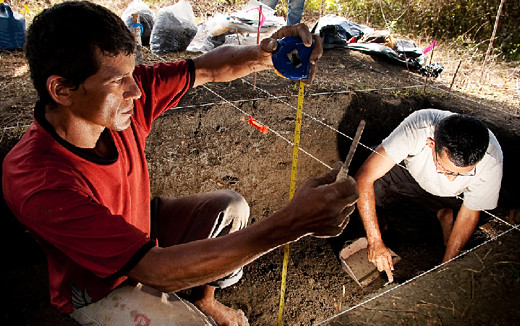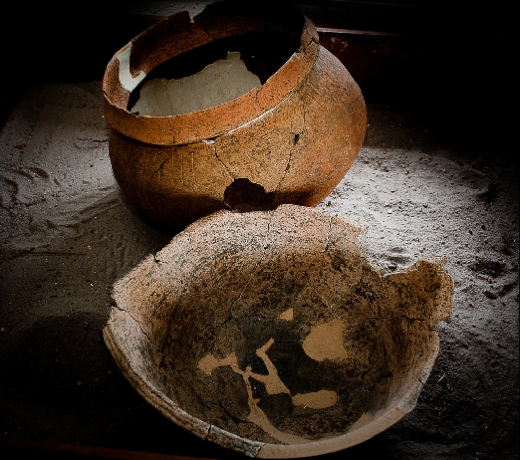
Image above: Men work on an excavation in the Brazilian Amazon rain forest. From article.

By Juan Ferero on 5 August 2010 for the Washington Post -
(http://www.washingtonpost.com/wp-dyn/content/article/2010/09/03/AR2010090302302.html)
To the untrained eye, all evidence here in the heart of the Amazon signals virgin forest, untouched by man for time immemorial - from the ubiquitous fruit palms to the cry of howler monkeys, from the air thick with mosquitoes to the unruly tangle of jungle vines.
Archaeologists, many of them Americans, say the opposite is true: This patch of forest, and many others across the Amazon, was instead home to an advanced, even spectacular civilization that managed the forest and enriched infertile soil to feed thousands.
The findings are discrediting a once-bedrock theory of archaeology that long held that the Amazon, unlike much of the Americas, was a historical black hole, its environment too hostile and its earth too poor to have ever sustained big, sedentary societies. Only small and primitive hunter-gatherer tribes, the assumption went, could ever have eked out a living in an unforgiving environment.
But scientists now believe that instead of stone-age tribes, like the groups that occasionally emerge from the forest today, the Indians who inhabited the Amazon centuries ago numbered as many as 20 million, far more people than live here today.
"There is a gigantic footprint in the forest," said Augusto Oyuela-Caycedo, 49, a Colombian-born professor at the University of Florida who is working this swath in northeast Peru.
Stooping over a man-made Indian mound on a recent day, he picked up shards of ceramics and dark, nutrient-rich earth made fertile hundreds of years ago by human hands. "All you can see is an artifact of the past," he said. "It's a product of human actions," he said.
The evidence is not just here outside tiny San Martin de Samiria, an indigenous hamlet hours by speed boat from the jungle city of Iquitos. It is found across Amazonia.
Outside Manaus, Brazil, Eduardo Neves, a renowned Brazilian archaeologist, and American scientists have found huge swaths of "terra preta," so-called Indian dark earth, land made fertile by mixing charcoal, human waste and other organic matter with soil. In 15 years of work they have also found vast orchards of semi-domesticated fruit trees, though they appear like forest untrammeled by man.

Image above: Ancient indigenous Manacapuru pottery was recovered in 2006. From article.
Along the Xingu, an Amazon tributary in Brazil, Michael Heckenberger of the University of Florida has found moats, causeways, canals, the networks of a stratified civilization that, he says, existed as early as A.D. 800. In Bolivia, American, German and Finnish archaeologists have been studying how pre-Columbian Indians moved tons of soil and diverted rivers, major projects of a society that existed long before the birth of Christ.
Many of these ongoing excavations follow the work of Anna C. Roosevelt. In the 1980s on Marajo Island, at the mouth of the Amazon, she turned up house foundations, elaborate pottery and evidence of an agriculture so advanced she believes the society there possibly had well over 100,000 inhabitants.
Her initial conclusions, published in 1991, helped redirect scientific thinking about Amazonia, with younger archaeologists who followed buttressing and building upon her findings.
"I think we're humanizing the history of the Amazon," said Neves, 44, a professor at the University of Sao Paulo. "We're not looking at the Amazon anymore as a black box. We're seeing that these people were just like anywhere else in the world. We're giving them a sense of history."
The number of scientists who disagree has diminished, but influential critics remain, none more so than Betty J. Meggers, director of Latin American archaeology at the Smithsonian Institution. She said the new theories are based more on wishful thinking than science.
"I'm sorry to say that archaeologists like to produce sensational refutation of previous theories," said Meggers, whose 1971 book, "Amazonia: Man and Culture in a Counterfeit Paradise," holds that the region is unfit for large-scale habitation. "You know, this is how you get your promotions."
There is also concern among some that the new theories could pose a danger to the Amazon. If the forest were not as unspoiled as previously thought, they wonder, then wouldn't that serve as a green light to developers today?
"Just because the indigenous had complex societies that managed the forest can't justify the large-scale transformations in the Amazon today," said Zach Hurwitz, a geographer who consults International Rivers, a Berkeley, Calif.-based environmental group that has raised concerns about dam building projects and mineral exploration.
A study of contrasts
In some ways, the theory that the Amazon may have been a wellspring of civilization should come as no surprise in the 21st century. In a long perilous journey along Ecuador's Napo River in 1541, Spanish friar Gaspar de Carvajal, a chronicler of the European conquest, wrote of "cities that gleamed white," canoes that carried dozens of Indian warriors, "fine highways" and "very fruitful land."
But until recently, scientists and explorers had all but rejected his work as fantastical, the diaries of a man who would write anything to justify to investors back in Spain that the hunt for El Dorado would bear fruit.
In sharp contrast, explorers in the 20th century noted that the Amazon held no pyramids or stone aqueducts, like those of Mexico. And the people they encountered belonged to small bands - Amazonian Indians who appeared to be little more than human relics forgotten by time.
Roosevelt, a professor of anthropology at the University of Illinois, said that was because the civilizations encountered by Europeans quickly disintegrated, victims of disease.
But until their demise, she said, their cultures were anything but primitive. "They have magnitude, they have complexity," she said. "They are amazing."
See also:
Ea O Ka Aina: Black is the New Green 2/28/10
Ea O Ka Aina: Soylent Black 1/14/09
Island Breath: Rethinking Biochar 10/15/07
.
No comments :
Post a Comment